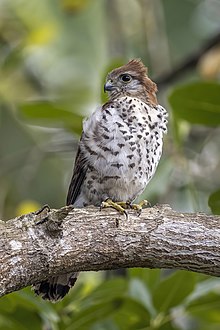
Phelsuma is a large genus of geckos in the family Gekkonidae. Species in the genus Phelsuma are commonly referred to as day geckos.

Barbour's day gecko is a species of lizard in the family Gekkonidae. The species is endemic to central Madagascar. It is diurnal and typically dwells on rocks. Barbour's day gecko feeds on insects and nectar.

Phelsuma dubia, also known as dull day gecko, olive day gecko, Zanzibar day gecko or green day gecko, is a diurnal species of gecko. It is about 15 centimetres (5.9 in) in length and lives on the western coast of Madagascar, in the Comoros, and the coast of East Africa. It typically inhabits trees and can also be found near human dwellings. The Dull day gecko feeds on insects and nectar.

The Rodrigues day gecko, also known commonly as the Rodrigues blue-dotted day gecko, is an extinct species of day gecko, a lizard in the family Gekkonidae. The species was endemic to the island of Rodrigues, where it typically inhabited forests and dwelt in trees. The Rodrigues day gecko fed on insects and nectar.

The Round Island day gecko, also known commonly as Günther's gecko, is an endangered species of lizard in the family Gekkonidae. The species is endemic to the islet Round Island, Mauritius, and typically dwells on palm trees. The Round Island day gecko feeds on insects and nectar.

The Mauritius lowland forest day gecko, also known commonly as Guimbeau's day gecko and the orange-spotted day gecko, is a diurnal species of gecko, a lizard in the family Gekkonidae. The species is native to the western coast of Mauritius and typically inhabits large trees. The Mauritius lowland forest day gecko feeds on insects and nectar.
Mauritius upland forest day gecko is a diurnal species of geckos.
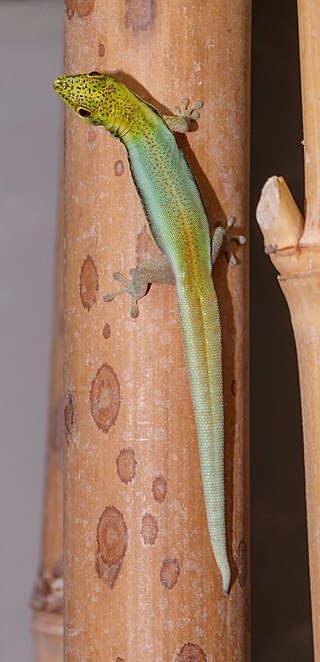
The yellow-headed day gecko, also commonly called Klemmer's day gecko, the neon day gecko, or the cheerful day gecko, is a small diurnal species of gecko, a lizard in the family Gekkonidae. This endangered species is endemic to northwestern Madagascar and inhabits coastal forests, dwelling on bamboo. The yellow-headed day gecko feeds on insects and nectar.

The gold dust day gecko is a diurnal species of gecko. It lives in northern Madagascar, Tanzania, and on the island of Comoros; it has also been introduced to Hawaii and other Pacific islands. It's typically seen in houses and various trees. The gold dust day gecko feeds on insects and nectar.
Phelsuma laticauda angularisMertens, 1964 is a diurnal subspecies of geckos. It lives in northern Madagascar and typically inhabits different trees and houses. The Gold dust day gecko feeds on insects and nectar.
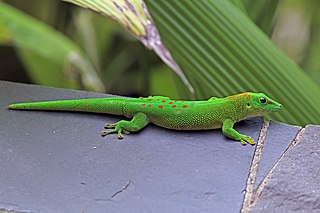
Phelsuma grandis is a diurnal arboreal species of day gecko. These geckos are part of the Phelsuma group, which consists of in excess of 70 species and subspecies. They are commonly referred to as the Madagascar giant day gecko, due to their large size. They are native to areas of tropical and subtropical forest in northern Madagascar, but have been introduced to several other subtropical locations outside their range. P. grandis feeds on various invertebrates, very small vertebrates, and nectars. It is bred and sold as an exotic pet.

The flat-tailed day gecko is a diurnal gecko lives in eastern Madagascar. It is endangered due to illegal collection for the international pet trade. It typically inhabits rainforests and dwells on trees. The flat-tailed day gecko feeds on insects and nectar.
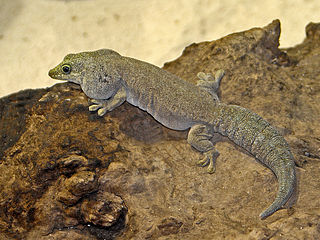
Standing's day gecko is an arboreal and diurnal species of lizard in the family Gekkonidae. The species is endemic to southwest Madagascar; it is threatened by illegal collection for the international pet trade and habitat loss. It is among the largest living species of day geckos. Standing's day gecko feeds on insects and nectar.

Seychelles giant day gecko is a diurnal subspecies of geckos. It lives on the island Praslin in the Seychelles and typically inhabits trees and dwellings. The Seychelles giant day gecko feeds on insects and nectar.

Phelsuma sundbergi ladiguensis is a diurnal subspecies of Phelsuma sundbergi. It lives on the islands Ladigue, Felicite and Cocco in the Seychelles, and typically inhabits trees and dwellings. The Seychelles giant day gecko feeds on insects and nectar.

Mauritius ornate day gecko is a diurnal species of gecko. It occurs on the island of Mauritius and some surrounding islands and typically inhabits different trees and bushes. The Mauritius ornate day gecko feeds on insects and nectar.
Phelsuma parkeri, commonly known as Parker's day gecko or the Pemba Island day gecko, is a diurnal species of lizard in the family Gekkonidae. The species is endemic to Pemba Island, Tanzania, and typically inhabits banana trees and dwellings. The Pemba Island day gecko feeds on insects and nectar.
Phelsuma pusilla hallmanni is a diurnal subspecies of gecko, a lizard in the family Gekkonidae. The subspecies is endemic to eastern Madagascar and typically inhabits different trees. This day gecko feeds on insects and nectar.
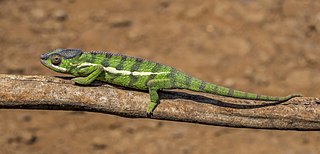
The wildlife of Réunion is composed of its flora, fauna and funga. Being a small island, it only has nine native species of mammals, but ninety-one species of birds.
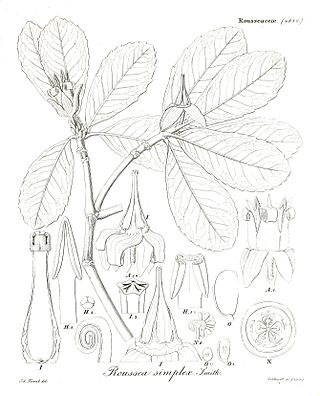
Roussea simplex is a woody climber of 4–6 m high, that is endemic to the mountain forest of Mauritius. It is the only species of the genus Roussea, which is assigned to the family Rousseaceae. It has opposing, entire, obovate, green leaves, with modest teeth towards the tip and mostly pentamerous, drooping flowers with yellowish recurved tepals, and a purse-shaped orange corolla with strongly recurved narrowly triangular lobes.




